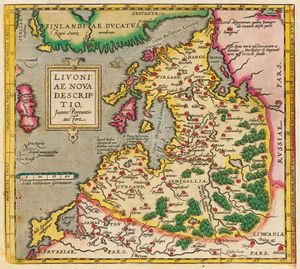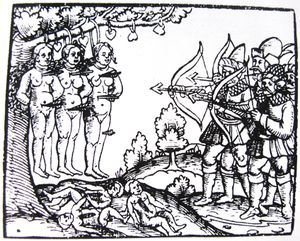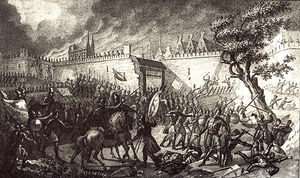Livonian War
|
Livonian War
|
|
Narva (1558) – Ergeme – Reval (1571–1572) – Wesenberg – Reval (1576–1577) – Wenden (1577–1578) – Narva (1581) – Báthory's campaign (1577–1582) (Pskov)
Treaties
|
|
|
Polish–Swedish Wars
|
|
Livonian – Sigismund – 1600–11 – 1617–18 – 1621–25 – 1626–29 – 2nd Northern (Deluge) – Great Northern – War of the Fourth Coalition – War of the Sixth Coalition
|
|

Map of Livonia in 1573
The Livonian War of 1558–1583 was a lengthy series of wars between the Tsardom of Russia and a variable coalition of Denmark–Norway, Grand Duchy of Lithuania, the Kingdom of Poland , and Sweden for control of medieval Livonia, the territory of the present-day Estonia and Latvia.
Prelude
By the late 1550s, the Livonian Confederation disintegrated over a series of internal disputes, while its Eastern neighbour Russia had grown stronger after annexing the khanates of Kazan (1552) and Astrakhan (1556). The conflict between Russia and the Western powers was exacerbated by Russia's isolation from sea trade. Nor could the tsar hire qualified labour in Europe. Competition for the Baltic coast with Sweden had escalated into open war in 1554, interrupted only by a fragile truce in March 1557.
In 1547, Hans Schlitte, the agent of Tsar Ivan IV, employed handicraftsmen in Germany for work in Russia. However all these handicraftsmen were arrested in Lübeck at the request of Livonia.[1] The German Hanseatic League ignored the new Ivangorod port built by tsar Ivan on the eastern shore of the Narva River in 1550 and continued to trade with the ports owned by Livonia.[2]
Tsar Ivan IV demanded that the Livonian Confederation pay 40,000 thalers for the Bishopric of Dorpat, based on a claim that the territory had once been owned by the Russian Novgorod Republic. The federation turned to the Polish-Lithuanian union in the Treaty of Pozvol, regarded by Ivan IV as casus belli.[3]
1558–1578: Russian dominance, Kingdom of Livonia
The dispute ended with a Russian invasion in 1558. Russian troops occupied Dorpat (Tartu) and Narva, laying siege to Reval (Tallinn). The goal of Tsar Ivan was to gain vital access to the Baltic Sea.
Tsar Ivan's actions conflicted with the interests of other countries. In the wake of the disastrous Battle of Ergeme (Ermes), the weakened Livonian Order was dissolved in 1561 by the Treaty of Vilnius (Vilna, Wilno): The order assigned its lands, secularized as Duchy of Livonia and Duchy of Courland and Semigallia, to the Grand Duchy of Lithuania (after 1569 the Polish–Lithuanian Commonwealth). The order's last Grand Master Gotthard Kettler became duke of Courland.
The city council of Reval turned to King Eric XIV of Sweden for help against other troops. In 1561, Swedish forces arrived and the noble corporations of Harria–Vironia (Harrien-Wierland, Harju–Viru) and Jervia (Jerwen, Järva) yielded to Sweden, forming the Duchy of Estonia.[4]
Frederick II of Denmark sent troops to protect the western Estonian territories he had recently bought from the bishop of Ösel–Wiek. Quarrels between Denmark and Sweden led to the contemporary Northern Seven Years' War in the Baltic, concluded only in 1570 by the Treaty of Stettin.
By 1562, Russia found itself in wars with Lithuania and Sweden. Ivan IV's armies scored several successes, taking Polotsk (1563) and Pernau (Pärnu) (1575), and overrunning much of Lithuania up to Vilnius, which led the tsar to reject peace proposals from his enemies. A Swedish counter-offensive was stalled when in the Siege of Wesenberg (1574), German and Scottish units of the Swedish army turned against each other.[5] After a series of successful Russian offensives, Sweden and Poland-Lithuania seized the initiative after the Battle of Wenden (1578), the turning point in the war.[6]
The battles of Wenden also marked the end of Magnus of Livonia's Kingdom of Livonia, a wartime entity backed by part of the Livonian gentry to preserve their heriditary privileges, primarily by accepting vassalage to Russia in turn for respective garantuees.
1578–1583: Swedish and Polish-Lithuanian dominance, truces

Russian atrocities in Livonia. Printed in "Zeyttung" published in
Nuremberg in 1561.
The Tsar found himself in a difficult position by 1579. The Crimean Tatars devastated Russian territories and burnt down Moscow (see Russo-Crimean Wars), the drought and epidemics have fatally affected the economy, and Oprichnina had thoroughly disrupted the government, while Lithuania had united with Poland (new union in 1569) and acquired an energetic leader, king Stefan Batory. In a successful campaign, not only did Batory reconquer Polotsk (1579), but he also seized Russian fortresses at Sokol, Velizh, Usvzat, Velikie Luki (1580), and laid siege to Pskov (1581–82). Polish-Lithuanian cavalry devastated the regions of Smolensk, Chernigov, Ryazan, southwest of the Veliky Novgorod,[7] and even reached the Tsar's residences in Staritsa. Ivan prepared to fight, but the Poles retreated[8]. In 1581, a mercenary army hired by Sweden and commanded by Pontus de la Gardie re-captured the strategic city of Narva, that had been taken by Ivan's troops 20 years before, and massacred its inhabitants, 7,000 people in retaliation for previous Russian massacres. [9].
These developments led to the signing of the peace Truce of Jam Zapolski in 1582 between Russia and the Polish-Lithuanian Commonwealth in which Russia renounced its claims to Livonia. The Jesuit papal legate Antonio Possevino was involved in negotiating that treaty. The following year, the war ended when the Tsar concluded the Truce of Plussa (Plyussa, Pljussa, Plusa) with Sweden, relinquishing most of Ingria. The situation was reversed 12 years later, according to the Treaty of Teusina (Tyavzino, Tyavzin) which concluded a new war between Sweden and Russia.
References
- This article incorporates material from the public domain 1906 Brockhaus and Efron Encyclopedic Dictionary.
- ↑ Karamzin N.M. "The History of Russia", volume VIII (Documents from the Archive of Koenigsberg)
- ↑ "The Full Collection of Russian Annals", vol. 13, SPb, 1904
- ↑ De Madariaga, Isabel (2006). Ivan the Terrible. Yale University Press. p. 127. ISBN 0300119739.
- ↑ Eriksson, Bo (2007) (in Swedish). Lützen 1632. Stockholm: Norstedts Pocket. pp. 45–46. ISBN 978-91-7263-790-0.
- ↑ Peterson, Gary Dean (2007). Warrior kings of Sweden. The rise of an empire in the sixteenth and seventeenth centuries. McFarland. pp. 91–93. ISBN 0786428732.
- ↑ Peterson, Gary Dean (2007). Warrior kings of Sweden. The rise of an empire in the sixteenth and seventeenth centuries. McFarland. p. 94. ISBN 0786428732.
- ↑ Rheinhold Heidenstein. "The Notes about the Moscow war". (1578–1582), SPb, 1889
- ↑ Sergey Solovyov. History of Russia from the Earliest Times, ISBN 5-17-002142-9, v.6
- ↑ Sergey Solovyov. History of Russia from the Earliest Times, ISBN 5-17-002142-9, v.6, p.881
External links
|
Treaties of the Livonian War (1558–1583) |
|
|
Pozvol – Vilnius (1559) – Novgorod – Vilnius (1561) – Dorpat – Grodno – Stettin – Drohiczyn – Jam Zapolski – Narva-Plussa
|
|
| Campaigns |
|
|
|
|
| Piast Poland |
972 war against Germany (Battle of Cedynia) · 1003–1005 war against Germany · 1007–1013 war against Germany · 1015–1018 war against Germany · 1018 war against Kievan Rus' · 1072 war against Bohemia · 1109 war against Germany · 1146 war against Germany · 1156 war against Germany · Mongol invasion of Europe (Battle of Legnica) · 1326–1333 war against the Teutonic Order (Battle of Płowce) · Galicia–Volhynia Wars
|


 |
|
| Jagiellon Poland |
Polish–Lithuanian–Teutonic War (Battle of Grunwald) · Polish–Teutonic War (1414) · Polish–Teutonic War (1422) · Lithuanian Civil War (1431–1435) · Battle of Grotniki · 1444 war against the Ottomans (Battle of Varna) · Thirteen Years' War · War of the Priests · Polish–Moldavian War · Polish–Lithuanian–Muscovite War (1512–1522) · Polish–Teutonic War (1519–21) · Polish–Lithuanian–Muscovite War (1534–1537) · Ottoman–Tatar Invasion of Lithuania and Poland
|
|
| Commonwealth |
Northern Seven Years' War · Danzig rebellion (Battle of Lubiszewo) · Siege of Danzig (1577) · Livonian War · War of the Polish Succession (1587–1588) (Battle of Byczyna) · 1589 Tatar Invasion · Kosiński Uprising · 1593 Tatar Invasion · Nalyvaiko Uprising · Moldavian Magnate Wars · Polish–Ottoman War (1620–1621) · Polish–Swedish wars · War against Sigismund (Battle of Stångebro) · Polish–Swedish War (1600–1629) (Polish–Swedish War (1600–1611) · Polish–Swedish War (1617–1618) · Polish–Swedish War (1621–1625) · Polish–Swedish War (1626–1629)) · Polish–Muscovite War (1605–1618) · Zebrzydowski Rebellion · Thirty Years' War · Polish–Ottoman War (1620–1621) (Battle of Cecora) · 1624 Tatar Invasion · Żmajła Uprising · Fedorovych Uprising (Battle of Korsuń) · Smolensk War · Polish–Ottoman War (1633–1634) · Pawluk Uprising · Ostrzanin Uprising · 1644 Tatar Invasion · Khmelnytsky Uprising · Russo-Polish War (1654–1667) · Second Northern War (The Deluge) · Russo-Polish War (1654–1667) · Polish–Cossack–Tatar War (1666–1671) · Polish–Ottoman War (1672–1676) · Polish–Ottoman War (1683–1699) (Battle of Vienna) · Great Northern War · War of the Polish Succession · Bar Confederation · Polish–Russian War of 1792 · Kościuszko Uprising
|
|
| Polish Partition |
|
|
| Second Republic |
|
|
| Second World War |
|
|
| People's Republic |
|
|
| Third Republic |
|
|





